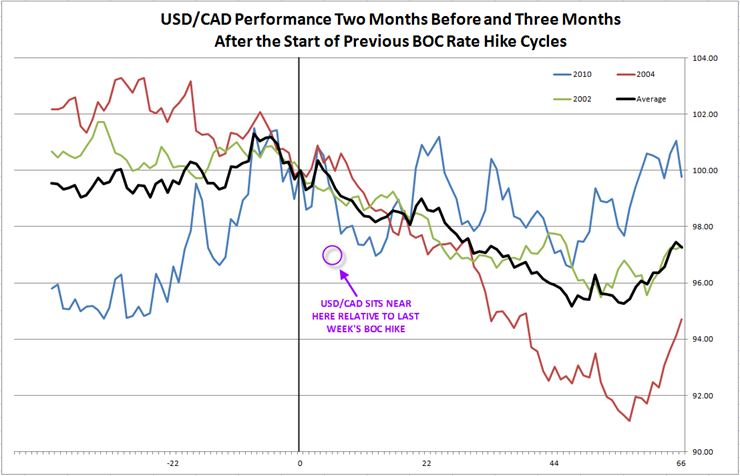
Last week’s price action in the Canadian dollar marked a major “sea change” for the currency.
Whereas the loonie had previously been lumped in with the other commodity dollars struggling to recover from the big downdraft in the price of hard goods, last Wednesday’s rate hike from the Bank of Canada injected new life into the currency. Just as importantly, the central bank’s shift to a more hawkish posture, including upgrading its GDP forecasts for both 2017 and 2018, has made the loonie arguably the most attractive risk-on, “carry trade” play in the G10 world heading into the second half of the year.
It’s easy to get carried away with such hyperbole in the wake of sharp market moves, so we wanted to take a step back and examine how the Canadian dollar performed at the start of previous rate hike cycles from the BOC.
Accordingly, the chart below shows the performance of USD/CAD at the start of last three BOC rate hike “cycles” (defined as the first interest rate rise after a series of cuts), as well as the average of the three. In each case, USD/CAD levels are normalized at 100 on the day of the initial hike and the chart shows the pair’s performance in the two months prior to the initial hike and the three months afterward. As a reminder, this is a chart of USD/CAD, so falling values indicate strength in the Canadian dollar.

Source: Investing.com & Faraday Research. For reference, the initial BOC interest rate increases took place on April 16, 2002; September 8, 2004; and June 1, 2010.
As the chart above shows, the USD/CAD’s performance leading into the BOC’s decision to start raising rates varied in each of the prior three rate hike cycles. In contrast, USD/CAD was uniformly weak (signaling loonie strength) following the start of a tightening regime, especially for the first couple of weeks. In none of the three examples shown was USD/CAD trading meaningfully higher than pre-hike levels at any point in the three months after the initial interest rate raise, though 2010’s cycle didn’t feature much of a trend either way.
















